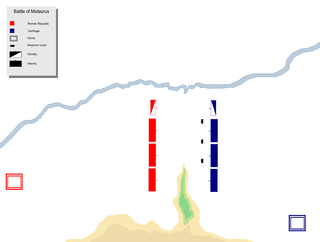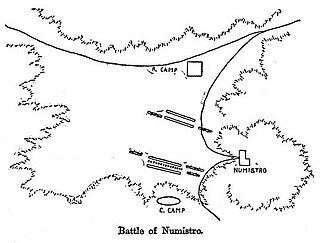This article concerns the period 219 BC – 210 BC.
Year 212 BC was a year of the pre-Julian Roman calendar. At the time it was known as the Year of the Consulship of Flaccus and Pulcher. The denomination 212 BC for this year has been used since the early medieval period, when the Anno Domini calendar era became the prevalent method in Europe for naming years.

Year 216 BC was a year of the pre-Julian Roman calendar. At the time it was known as the Year of the Consulship of Varro and Paullus. The denomination 216 BC for this year has been used since the early medieval period, when the Anno Domini calendar era became the prevalent method in Europe for naming years.

Marcus Claudius Marcellus, five times elected as consul of the Roman Republic, was an important Roman military leader during the Gallic War of 225 BC and the Second Punic War. Marcellus gained the most prestigious award a Roman general could earn, the spolia opima, for killing the Gallic military leader and king Viridomarus in single combat in 222 BC at the Battle of Clastidium. Furthermore, he is noted for having conquered the fortified city of Syracuse in a protracted siege during which Archimedes, the famous mathematician, scientist, and inventor, was killed, despite Marcellus ordering the soldiers under his command not to harm him. Marcus Claudius Marcellus died in battle in 208 BC, leaving behind a legacy of military conquests and a reinvigorated Roman legend of the spolia opima.

The Battle of the Metaurus was a pivotal battle in the Second Punic War between Rome and Carthage, fought in 207 BC near the Metauro River in Italy. The Carthaginians were led by Hasdrubal Barca, brother of Hannibal, who was to have brought siege equipment and reinforcements for Hannibal. The Roman armies were led by the consuls Marcus Livius, who was later nicknamed the Salinator, and Gaius Claudius Nero.
Appius Claudius Pulcher was a Roman general and politician of the 3rd century BC, active in the Second Punic War.

Gaius Claudius Nero was a Roman general active during the Second Punic War against the invading Carthaginian force, led by Hannibal Barca. During a military career that began as legate in 214 BC, he was praetor in 212 BC, propraetor in 211 BC during the siege of Capua, before being sent to Spain that same year. He became consul in 207 BC.
Marcus Livius Salinator was a Roman general and politician who fought in the Second Punic War, most notably during the Battle of the Metaurus.

The first Battle of Herdonia was fought in 212 BC during the Second Punic War between Hannibal's Carthaginian army and Roman forces led by Praetor Gnaeus Fulvius Flaccus, brother of the consul. The Roman army was destroyed, leaving Apulia free of Romans for the year.

The second battle of Herdonia took place in 210 BC during the Second Punic War. Hannibal, leader of the Carthaginians, who had invaded Italy eight years earlier, encircled and destroyed a Roman army which was operating against his allies in Apulia. The heavy defeat increased the war's burden on Rome and, piled on previous military disasters, aggravated the relations with her exhausted Italian allies. For Hannibal the battle was a tactical success, but did not halt for long the Roman advance. Within the next three years the Romans reconquered most of the territories and cities lost at the beginning of the war and pushed the Carthaginian general to the southwestern end of the Apennine peninsula. The battle was the last Carthaginian victory of the war; all battles which followed were either inconclusive or Roman victories.

The First Battle of Capua was fought in 212 BC between Hannibal and two Roman consular armies. The Roman force was led by two consuls, Quintus Fulvius Flaccus and Appius Claudius Pulcher. The Roman force was defeated, but managed to escape. Hannibal temporarily managed to raise the siege of Capua. A tactical Carthaginian victory, it ultimately did not help the Capuans.

The Battle of Numistro was fought in 210 BC between Hannibal's army and one of the Roman consular armies led by consul Marcus Claudius Marcellus. It was the fourth time they met in a battle. Previous encounters were located around the walls of Nola (Campania) in 216, 215, and 214 and had been favourable for the Roman side.
Hanno, distinguished as the son of the suffet Bomilcar, was a Carthaginian officer in the Second Punic War.

The Battle of Tarentum in March 212 BC was a military engagement in the Second Punic War.

The Battle of Beneventum was fought in 214 BC near modern Benevento during the Second Punic War. Roman legions under Tiberius Sempronius Gracchus defeated Hanno's Carthaginian forces, denying Hannibal reinforcements. Livy gives a brief description of the battle, which was part of the Roman campaign to subdue the southern Italian city-states that had joined Hannibal after the Battle of Cannae.

The Battle of Canusium also known as the Battle of Asculum was a three-day engagement between the forces of Rome and Carthage. It took place in Apulia during the spring of 209 BC, the tenth year of the Second Punic War. A larger Roman offensive, of which it was a part, aimed to subjugate and to punish cities and tribes that had abandoned the alliance with Rome after the Battle of Cannae, and to narrow the base of the Carthaginian leader, Hannibal, in southern Italy.
Pacuvius Calavius was the chief magistrate of Capua during the Second Punic War. In the aftermath of the Battle of Lake Trasimene, he prevented the people of Capua from surrendering the city to Hannibal. When the Capuans finally capitulated, he dissuaded his son from a rash attempt on the life of the Carthaginian general.
Lucius Veturius Philo was a curule aedile in 210 BC, praetor of Cisalpine Gaul in 209 BC, propraetor of the same province in 208 BC, consular legate in 207 BC, consul in 206 BC, and magister equitum in 205 BC. He was renowned for having been the first to announce to the Roman Senate the news of the great victory won over Hannibal Barca at the Battle of Zama, which ended the Second Punic War.

The Hannibal's raid to Rome occurred in 211 BC during the Second Punic War; the Carthaginian leader Hannibal marched by surprise with his army towards Rome, initially causing great concern among the leaders and citizens of the republic. The raid, however, ended in failure; soon, faced with firm resistance from the Romans, Hannibal left the city to head with his troops to Campania.















